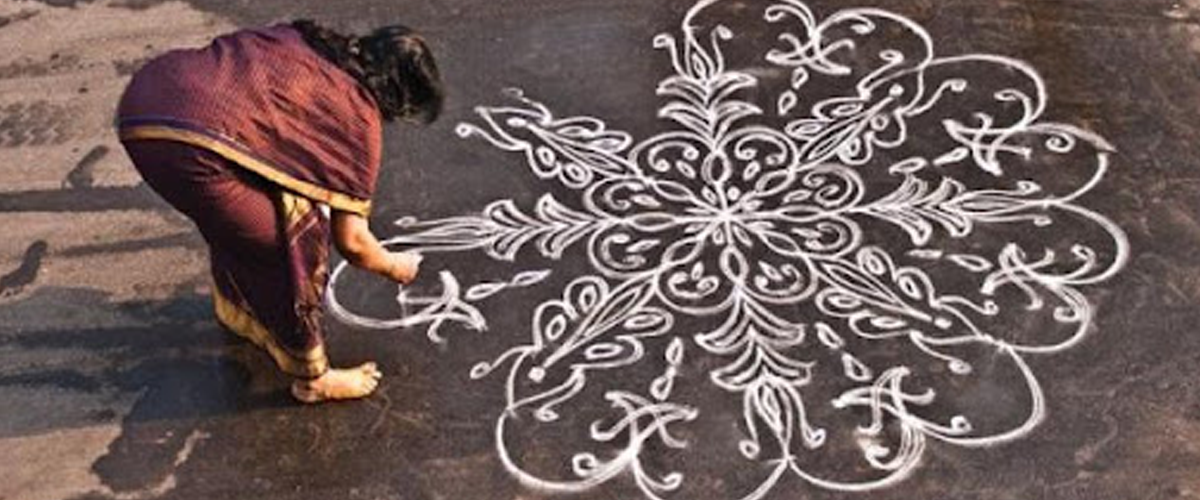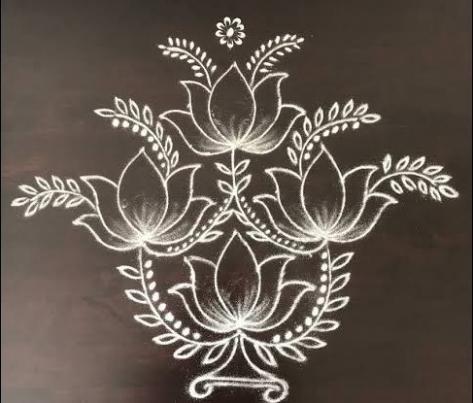RANGOLI
-
Harine Rajkumar
- Posted on
- 0 comments

Rangoli : A Colorful and Creative Expression of Indian Folk Art.
The making of colorful patterns on the floor using a mix of materials such as sand, flower petals, rice flour and lentils is what forms a Rangoli – one of the most beautiful Indian folk arts.


Rangoli is an ancient art form of India, used to decorate and beautify the home. It involves creating intricate designs and patterns with natural materials like colored sand, rice, and flowers. In modern times, rangoli is also used to celebrate festivals and special occasions.
Each state of India has its own way of making Rangoli and they are called by different names.
- Andhra Pradesh – Muggu
- Bihar – Aripana
- Chattisgarh – Chauk Purna
- Gujarat – Sathiya
- West Bengal – Alpana
- Karnataka – Rangavalli
- Tamilnadu – Kolam
- Rajasthan – Mandana
- Orissa – Osa
- Kerala – Poovidal or Kolam

Now, How did the name Rangoli Originate ?
The word “Rangoli” is derived from the Sanskrit word “rangavalli” which means “line drawing”. It is believed that the art form of rangoli originated during the time of the ancient Indus Valley civilization. Rangoli has a long and rich history, and it has been used in India for centuries to decorate homes and public spaces. It is a form of art that is believed to bring good luck and ward off evil spirits. The vibrant colors used in rangoli symbolize joy, hope, and happiness.
Origin of Rangoli
There are two types of Rangoli : Dry Rangoli and Wet Rangoli.
The dry rangoli originated from a woman called Lopamudra, the wife of the sage, Augustya Rishi. She has also written 2 portions of the Rigveda (famous holy books). Living in a remote place, away from others, the people would recognize them as hermits (who lives alone, away from people and society). Lopamudra wanted to help her husband in worshiping the gods and so she created rangoli – a decoration for the Yagyakunda – a place of worship. To make the rangoli, she asked the Panchatatva (the five elements – sky, wind, water, earth, fire) to provide her with colors. The elements each gifted her with blue from the sky, green from the water, black from the soil, red from the fire and white from the wind. She then added these colors to the rangoli design, which is why they look so beautiful today.
The wet form of rangoli was introduced by Seeta, the beloved of Rama from the famous story of Ramayana. When Seeta fell in love with Rama, she created a wet rangoli design with ground rice. She then prayed to the Goddess Gauri (wife of Shiva) to grant her wish of having Rama as her husband. Thus, the wet rangoli has become a popular way to celebrate love and devotion in India.

Rangoli and its Colors
- Blue represents the sky and green represents the sea. Both colors bring calm and helps with using our imagination. These are good colors for story telling.
- Black brings strength and stability.
- Red, the colour of fire or danger, represents the code of conduct the artist must follow.
- White represents peace and positivity and embodies all colors.
History of Rangoli
Rangoli is an ancient art form of Hinduism which has its roots in the Vedic times. It dates back to the prehistoric Stone Age, when early humans, also known as cavemen, believed that the five elements – Fire, Water, Air, Soil and Space – influenced every aspect of their lives. To protect themselves from evil and negative energies, they used to draw intricate patterns in geometric shapes to attract positive energies. These designs predominantly contained the elements of nature such as the Sun, Fire, trees, birds, animals, and flowers. Motifs like Swastika, crosses, circles, snakes, and Goddesses were also found in cave form paintings in ancient India. Over time, the art form has evolved and modern designs have many straight lines and modern shapes.
Rangoli in Ancient Hindu
The holy epics of Ramayana, Bhagavata and Mahabharata have mentioned the prominence of Rangoli in various instances.
RAMAYANA
The story of Sita Mata’s kidnapping by Ravanan is well-known. Before leaving her alone in a hut in the forest, Lakshmana drew a circle of power around the hut and told Sita Mata not to cross it. But, she unintentionally crossed it, and the rest is history. According to folk tales, the circle that Lakshman drew was a form of Rangoli with divine powers. Lord Rama killed Ravanan at Dasara and returned to Ayodhya with Sita Mata on Diwali.
MAHABHARATA
The story of Subhadra and Lord Krishna tells of the importance of this visual art. On an Ekadashi day, the covering of drums and sticks of a tabor (a small drum with one head of soft calfskin) were damaged and the king ordered that whoever did not perform the Sankha Chakra Gopadma ritual that year would be deskinned and their skin will be used for the covering of the drums and their bones will be used for the sticks of the tabor. Everyone performed the ritual except Subhadra. Struck with guiltness, she ran to Lord krishna for help. Lord Krishna then suggested to decorate the house and cowshed with beautiful patterns of a swastika, Sankha, Chakra, Gada, Padma, leaves, flowers, sugarcane, and draw a cow shape on the floor and fill the stomach with 33 lotus flowers and worship it and circumambulate it 33 times. He assured that if she did these things with devotion, she would be freed from the sins of not performing the ritual and from the punishment.
The story about Subhadra And Lord Krishna tell the importance of this visual art. In the land where Subhadra, the sister of Lord Krishna resided, there was a celebration on an Ekadashi day that needed the playing of drums and Tabor(a small drum with one head of soft calfskin).
BHAGAVATA
The Gopikas were devoted worshippers of Lord Krishna and were heartbroken when he left town. To feel close to him, they drew his exact form on a clean surface and decorated it with colors and flowers. They used the art form to feel as though Krishna was still with them. The story of the Gopikas is a reminder of the power of Rangoli and its importance in Hindu culture.
Relation between Rangoli and Margazhli Month
In the month of Margazhi, Tamil Nadu dedicates itself to the worship of Lord Vishnu and Andal Amman. Long ago, there was a devotee of Lord Vishnu who had no children and prayed immensely for a baby. By the grace of Lord Vishnu, he was blessed with a daughter. He would ask her to make flower garlands for the worship of Lord Vishnu. The little girl would innocently test the garland for length and fragrance before submitting it for worship. One day, her father found a strand of her hair in the garland and was upset. However, Lord Vishnu appeared in his dream and told him that the garlands were acceptable. The girl, at the age of 15, considered Lord Vishnu as her husband and prayed for him during Margazhi. Thus, she was considered as the girl who was known to gain the heart of Lord Vishnu.

Thus, it is a norm for unmarried girls to wake up early during Margazhi to make beautiful designs on their house fronts to obtain good husbands. These designs symbolize Goddess Lakshmi and are worshipped as another form of her. These Hindu art designs are given immense importance and are believed to bring prosperity and good luck.
Scientific Reasons behind Rangoli
Rangoli is an ancient art form from India which is said to have many scientific benefits. Drawing rangoli requires skill and attention, creating shapes and patterns without any breakage or deformation of the symmetry. A closer look at the science behind rangoli reveals many intriguing facts. Geometric patterns are believed to evoke positive vibrations . The curved patterns, which join the dots, symbolize the infinite nature of the universe. The wave harmonics of sound that these patterns resemble have been proven to help with mental health issues such as depression and mental disorders.

Spiritual Significance of Rangoli
Rangoli is a form of art that is drawn in different patterns. It is believed to have a scientific and spiritual significance. Each type of Rangoli has a scientific reason and spiritual meaning behind it.
- The line forms that are usually drawn in Southern India and Tamilnadu are known to boost the Bhav (sentiment, feelings, attitude, affinity, absorption) emotion of spirituality.
- The Lotus forms that are drawn before the start of pujas and worship are known for their Chaitanya (Conciousnous) or energy evoking.
The designs in symmetry and square-shaped are proven for their energies they cause Ananda (extreme happiness) or bliss in humans.



Science behind Rangoli
- Rangolis, made from rice powder, provide food for small creatures like insects and birds, conveying the message that we should be mindful of other living beings on this planet.
- To draw kolams, women getup early before dawn and do their work. This habit of waking up before sunrise makes them healthy and wise.
- Drawing kolams in the early morning is a way to strengthen a woman both physically and spiritually.
- When drawing rangoli, people take care to make sure that the design is not broken. If any part of the design is distorted or wrong, people will often redo the entire design as it is believed that distorted shapes can attract bad energy.
- Positive and symmetrical shapes are used to invite gods and good energy, so care is taken to make sure the shape is even and without gaps. This is also true for when filling in the colors.
- When women draw rangoli and fill in colors, they use only their fingers. This is a type of Mudra technique which helps to increase their spiritual strength.

Thus the rangoli represents the happiness, positivity and liveliness of a household, and is intended to welcome Lakshmi, the goddess of wealth and good luck. It is also a way to express creativity and share joy with others. On important occasions like Diwali, it is believed to be auspicious to make rangoli. It is made of geometrical lines drawn on the floor, composed of curved loops and is meant to attract positive energy and ward off evil spirits. Rangoli is a beautiful way to bring people together and fill a home with joy and positivity.
Harine Rajkumar
Tiruvannamalai

